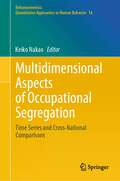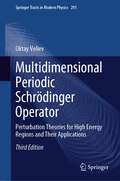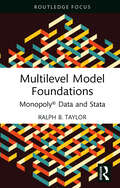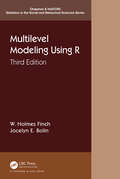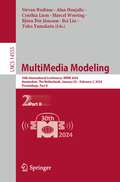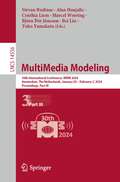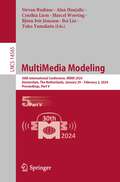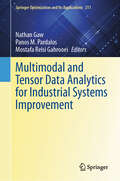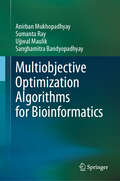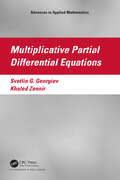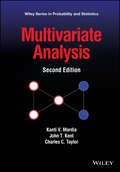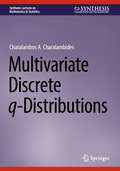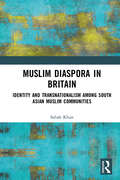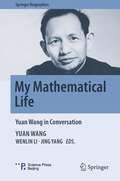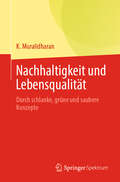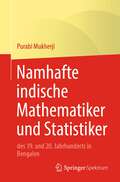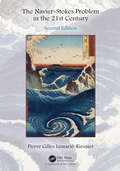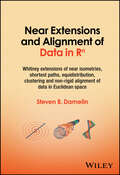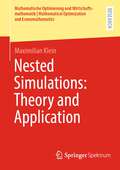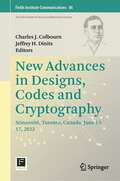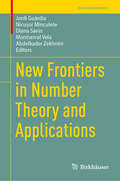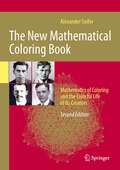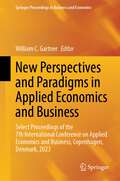- Table View
- List View
Multidimensional Aspects of Occupational Segregation: Time Series and Cross-National Comparisons (Behaviormetrics: Quantitative Approaches to Human Behavior #18)
by Keiko NakaoOne of the strengths of this book is that it expresses occupational segregation from multidimensional viewpoints using correspondence analysis. Through a quantitative approach, the book examines occupational segregation by education and gender in response to industrial transformation in Japan and other countries. The transformation of industrial structure, such as post-industrialization, demands a reconsideration of traditional perspectives in sociology, especially in social stratification. In other words, it is a shift from the attribute to the achievement principle. Higher technological innovations will create higher levels of industries, and those industries will require jobs that need greater human capital. In short, the meritocracy will be promoted. Meritocracy is certainly considered persuasive. In fact, previous researchers have looked primarily at a person’s occupation as a measure of social status. In Japan, jobs are normally acquired after completing education; thus, one’s educational achievement plays an important role. Especially in recent years, however, education alone has not been enough to explain social status. This book, therefore, focuses on occupational segregation by gender in addition to education in post-industrial society. Can occupational segregation by gender be weakened in the highly educated group? Is this a universal story in modern society? Because post-industrialization is part of the larger story of modernization, international perspectives are needed to examine the linkage between education and gender occupational segregation. This book explores occupational segregation by gender in response to industrial transformation in Japan and other countries.
Multidimensional Periodic Schrödinger Operator: Perturbation Theories for High Energy Regions and Their Applications (Springer Tracts in Modern Physics #291)
by Oktay VelievThis book describes the direct and inverse problems of the multidimensional Schrödinger operator with a periodic potential, a topic that is especially important in perturbation theory, constructive determination of spectral invariants and finding the periodic potential from the given Bloch eigenvalues. It provides a detailed derivation of the asymptotic formulas for Bloch eigenvalues and Bloch functions in arbitrary dimensions while constructing and estimating the measure of the iso-energetic surfaces in the high-energy regime. Moreover, it presents a unique method proving the validity of the Bethe–Sommerfeld conjecture for arbitrary dimensions and arbitrary lattices. Using the perturbation theory constructed, it determines the spectral invariants of the multidimensional operator from the given Bloch eigenvalues. Some of these invariants are explicitly expressed by the Fourier coefficients of the potential, making it possible to determine the potential constructively using Bloch eigenvalues as input data. Lastly, the book presents an algorithm for the unique determination of the potential.This updated and significantly expanded third edition features an extension of this framework to all dimensions, offering a now complete theory of self-adjoint Schrödinger operators within periodic potentials. Drawing from recent advancements in mathematical analysis, this edition delves even deeper into the intricacies of the subject. It explores the connections between the multidimensional Schrödinger operator, periodic potentials, and other fundamental areas of mathematical physics. The book's comprehensive approach equips both students and researchers with the tools to tackle complex problems and contribute to the ongoing exploration of quantum phenomena.
Multilevel Model Foundations: Monopoly® Data and Stata
by Ralph B. TaylorThis book introduces the foundations of multilevel models, using Monopoly® rent data, from the classic board game, and the statistical program Stata®. Widespread experience with the game means many readers have a head start on understanding these models. The small-data set, 132 rent values for 22 properties clustered by the four sides of the playing board, combines with extensive graphical displays of data and results so all readers can see core multilevel ideas in action at a granular level. Two chapters on standard statistical models, one-way analysis of variance and multiple regression, help readers see how multilevel models rely on but also extend these monolevel ideas. Chapters present three basic multilevel models for cross-sectional analyses – analysis of variance, analysis of covariance, and random coefficients regression – and one basic developmental model for longitudinal analyses. Troubleshooting guidance, combined with close examination of data patterns, and careful inspection of model parameters, all help readers better grasp what model results mean, when model results should or should not be trusted, and how model results link back to core theoretical questions. Consequently, readers will develop a sense of best practices for building and diagnosing their own multilevel models. Those who complete the volume can readily apply what they have learned to more complex datasets and models and adapt available online Stata do files to those projects. Any social scientist working with data clustered in time, in space, or in both, and seeking to learn more about how to use, interpret, or teach these models, will find the book useful.
Multilevel Modeling Using R (Chapman & Hall/CRC Statistics in the Social and Behavioral Sciences #16)
by W. Holmes Finch Jocelyn E. Bolin Ken KelleyLike its bestselling predecessor, Multilevel Modeling Using R, Third Edition provides the reader with a helpful guide to conducting multilevel data modeling using the R software environment.After reviewing standard linear models, the authors present the basics of multilevel models and explain how to fit these models using R. They then show how to employ multilevel modeling with longitudinal data and demonstrate the valuable graphical options in R. The book also describes models for categorical dependent variables in both single-level and multilevel data.The third edition of the book includes several new topics that were not present in the second edition. Specifically, a new chapter has been included, focussing on fitting multilevel latent variable modeling in the R environment. With R, it is possible to fit a variety of latent variable models in the multilevel context, including factor analysis, structural models, item response theory, and latent class models. The third edition also includes new sections in Chapter 11 describing two useful alternatives to standard multilevel models, fixed effects models and generalized estimating equations. These approaches are particularly useful with small samples and when the researcher is interested in modeling the correlation structure within higher-level units (e.g., schools). The third edition also includes a new section on mediation modeling in the multilevel context, in Chapter 11. This thoroughly updated revision gives the reader state-of-the-art tools to launch their own investigations in multilevel modeling and gain insight into their research.
MultiMedia Modeling: 30th International Conference, MMM 2024, Amsterdam, The Netherlands, January 29 – February 2, 2024, Proceedings, Part II (Lecture Notes in Computer Science #14555)
by Stevan Rudinac Alan Hanjalic Cynthia Liem Marcel Worring Björn Þór Jónsson Bei Liu Yoko YamakataThis book constitutes the refereed proceedings of the 30th International Conference on MultiMedia Modeling, MMM 2024, held in Amsterdam, The Netherlands, during January 29–February 2, 2024.The 112 full papers included in this volume were carefully reviewed and selected from 297 submissions. The MMM conference were organized in topics related to multimedia modelling, particularly: audio, image, video processing, coding and compression; multimodal analysis for retrieval applications, and multimedia fusion methods.
MultiMedia Modeling: 30th International Conference, MMM 2024, Amsterdam, The Netherlands, January 29 – February 2, 2024, Proceedings, Part III (Lecture Notes in Computer Science #14556)
by Stevan Rudinac Alan Hanjalic Cynthia Liem Marcel Worring Björn Þór Jónsson Bei Liu Yoko YamakataThis book constitutes the refereed proceedings of the 30th International Conference on MultiMedia Modeling, MMM 2024, held in Amsterdam, The Netherlands, during January 29–February 2, 2024.The 112 full papers included in this volume were carefully reviewed and selected from 297 submissions. The MMM conference were organized in topics related to multimedia modelling, particularly: audio, image, video processing, coding and compression; multimodal analysis for retrieval applications, and multimedia fusion methods.
MultiMedia Modeling: 30th International Conference, MMM 2024, Amsterdam, The Netherlands, January 29 – February 2, 2024, Proceedings, Part V (Lecture Notes in Computer Science #14565)
by Stevan Rudinac Alan Hanjalic Cynthia Liem Marcel Worring Björn Þór Jónsson Bei Liu Yoko YamakataThis book constitutes the refereed proceedings of the 30th International Conference on MultiMedia Modeling, MMM 2024, held in Amsterdam, The Netherlands, during January 29–February 2, 2024.The 120 full papers included in this volume were carefully reviewed and selected from 297 submissions. The MMM conference were organized in topics related to multimedia modelling, particularly: audio, image, video processing, coding and compression; multimodal analysis for retrieval applications, and multimedia fusion methods.
Multimodal and Tensor Data Analytics for Industrial Systems Improvement (Springer Optimization and Its Applications #211)
by Panos M. Pardalos Nathan Gaw Mostafa Reisi GahrooeiThis volume covers the latest methodologies for using multimodal data fusion and analytics across several applications. The curated content presents recent developments and challenges in multimodal data analytics and shines a light on a pathway toward new research developments. Chapters are composed by eminent researchers and practitioners who present their research results and ideas based on their expertise. As data collection instruments have improved in quality and quantity for many applications, there has been an unprecedented increase in the availability of data from multiple sources, known as modalities. Modalities express a large degree of heterogeneity in their form, scale, resolution, and accuracy. Determining how to optimally combine the data for prediction and characterization is becoming increasingly important. Several research studies have investigated integrating multimodality data and discussed the challenges and limitations of multimodal data fusion. This volume provides a topical overview of various methods in multimodal data fusion for industrial engineering and operations research applications, such as manufacturing and healthcare.Advancements in sensing technologies and the shift toward the Internet of Things (IoT) has transformed and will continue to transform data analytics by producing new requirements and more complex forms of data. The abundance of data creates an unprecedented opportunity to design more efficient systems and make near-optimal operational decisions. On the other hand, the structural complexity and heterogeneity of the generated data pose a significant challenge to extracting useful features and patterns for making use of the data and facilitating decision-making. Therefore, continual research is needed to develop new statistical and analytical methodologies that overcome these data challenges and turn them into opportunities.
Multiobjective Optimization Algorithms for Bioinformatics
by Ujjwal Maulik Sanghamitra Bandyopadhyay Anirban Mukhopadhyay Sumanta RayThis book provides an updated and in-depth introduction to the application of multiobjective optimization techniques in bioinformatics. In particular, it presents multiobjective solutions to a range of complex real-world bioinformatics problems. The authors first provide a comprehensive yet concise and self-contained introduction to relevant preliminary methodical constructions such as genetic algorithms, multiobjective optimization, data mining and several challenges in the bioinformatics domain. This is followed by several systematic applications of these techniques to real-world bioinformatics problems in the areas of gene expression and network biology. The book also features detailed theoretical and mathematical notes to facilitate reader comprehension. The book offers a valuable asset for a broad range of readers – from undergraduate to postgraduate, and as a textbook or reference work. Researchers and professionals can use the book not only to enrich their knowledge of multiobjective optimization and bioinformatics, but also as a comprehensive reference guide to applying and devising novel methods in bioinformatics and related domains.
Multiplicative Partial Differential Equations (Advances in Applied Mathematics)
by Svetlin G. Georgiev Khaled ZennirMultiplicative Partial Differential Equations presents an introduction to the theory of multiplicative partial differential equations (MPDEs). It is suitable for all types of basic courses on MPDEs. The author’s aim is to present a clear and well-organized treatment of the concept behind the development of mathematics and solution techniques. The text material of this book is presented in a highly readable, mathematically solid format. Many practical problems are illustrated displaying a wide variety of solution techniques. Features Includes new classification and canonical forms of second-order MPDEs Proposes a new technique to solving the multiplicative wave equation such as the method of separation of variables and the energy method The proposed technique in the book can be used to give the basic properties of multiplicative elliptic problems, fundamental solutions, multiplicative integral representation of multiplicative harmonic functions, mean-value formulas, strong principle of maximum, multiplicative Poisson equation, multiplicative Green functions, method of separation of variables, and theorems of Liouville and Harnack
Multiplicity of Time Scales in Complex Systems: Challenges for Sciences and Communication I (Mathematics Online First Collections)
by Bernhelm Booß-Bavnbek Katherine Richardson Jens Hesselbjerg Christensen Oriol Vallès CodinaThis highly interdisciplinary volume brings together a carefully curated set of case studies examining complex systems with multiple time scales (MTS) across a variety of fields: materials science, epidemiology, cell physiology, mathematics, climatology, energy transition planning, ecology, economics, sociology, history, and cultural studies. The book addresses the vast diversity of interacting processes underlying the behaviour of different complex systems, highlighting the multiplicity of characteristic time scales that are a common feature of many and showcases a rich variety of methodologies across disciplinary boundaries. Self-organizing, out-of-equilibrium, ever-evolving systems are ubiquitous in the natural and social world. Examples include the climate, ecosystems, living cells, epidemics, the human brain, and many socio-economic systems across history. Their dynamical behaviour poses great challenges in the pressing context of the climate crisis, since they may involve nonlinearities, feedback loops, and the emergence of spatial-temporal patterns, portrayed by resilience or instability, plasticity or rigidity; bifurcations, thresholds and tipping points; burst-in excitation or slow relaxation, and worlds of other asymptotic behaviour, hysteresis, and resistance to change. Chapters can be read individually by the reader with special interest in such behaviours of particular complex systems or in specific disciplinary perspectives. Read together, however, the case studies, opinion pieces, and meta-studies on MTS systems presented and analysed here combine to give the reader insights that are more than the sum of the book’s individual chapters, as surprising similarities become apparent in seemingly disparate and unconnected systems. MTS systems call into question naïve perceptions of time and complexity, moving beyond conventional ways of description, analysis, understanding, modelling, numerical prediction, and prescription of the worldaround us. This edited collection presents new ways of forecasting, introduces new means of control, and – perhaps as the most demanding task – it singles out a sustainable description of an MTS system under observation, offering a more nuanced interpretation of the floods of quantitative data and images made available by high- and low-frequency measurement tools in our unprecedented era of information flows.
Multiplicity of Time Scales in Complex Systems: Challenges for Sciences and Communication II (Mathematics Online First Collections)
by Bernhelm Booß-Bavnbek Katherine Richardson Jens Hesselbjerg Christensen Oriol Vallès CodinaNote to the interested reader to have a look at the companion to this volume Challenges for Sciences and Communication I | ISBN: 978-3-031-28048-1.This highly interdisciplinary volume brings together a carefully curated set of case studies examining complex systems with multiple time scales (MTS) across a variety of fields: materials science, epidemiology, cell physiology, mathematics, climatology, energy transition planning, ecology, economics, sociology, history, and cultural studies. The book addresses the vast diversity of interacting processes underlying the behaviour of different complex systems, highlighting the multiplicity of characteristic time scales that are a common feature of many and showcases a rich variety of methodologies across disciplinary boundaries. Self-organizing, out-of-equilibrium, ever-evolving systems are ubiquitous in the natural and social world. Examples include the climate, ecosystems, living cells, epidemics, the human brain, and many socio-economic systems across history. Their dynamical behaviour poses great challenges in the pressing context of the climate crisis, since they may involve nonlinearities, feedback loops, and the emergence of spatial-temporal patterns, portrayed by resilience or instability, plasticity or rigidity; bifurcations, thresholds and tipping points; burst-in excitation or slow relaxation, and worlds of other asymptotic behaviour, hysteresis, and resistance to change. Chapters can be read individually by the reader with special interest in such behaviours of particular complex systems or in specific disciplinary perspectives. Read together, however, the case studies, opinion pieces, and meta-studies on MTS systems presented and analysed here combine to give the reader insights that are more than the sum of the book’s individual chapters, as surprising similarities become apparent in seemingly disparate and unconnected systems. MTS systems call into question naïve perceptionsof time and complexity, moving beyond conventional ways of description, analysis, understanding, modelling, numerical prediction, and prescription of the world around us. This edited collection presents new ways of forecasting, introduces new means of control, and – perhaps as the most demanding task – it singles out a sustainable description of an MTS system under observation, offering a more nuanced interpretation of the floods of quantitative data and images made available by high- and low-frequency measurement tools in our unprecedented era of information flows.
Multivariate Analysis (Wiley Series in Probability and Statistics)
by Kanti V. Mardia John T. Kent Charles C. TaylorMultivariate Analysis Comprehensive Reference Work on Multivariate Analysis and its Applications The first edition of this book, by Mardia, Kent and Bibby, has been used globally for over 40 years. This second edition brings many topics up to date, with a special emphasis on recent developments. A wide range of material in multivariate analysis is covered, including the classical themes of multivariate normal theory, multivariate regression, inference, multidimensional scaling, factor analysis, cluster analysis and principal component analysis. The book also now covers modern developments such as graphical models, robust estimation, statistical learning, and high-dimensional methods. The book expertly blends theory and application, providing numerous worked examples and exercises at the end of each chapter. The reader is assumed to have a basic knowledge of mathematical statistics at an undergraduate level together with an elementary understanding of linear algebra. There are appendices which provide a background in matrix algebra, a summary of univariate statistics, a collection of statistical tables and a discussion of computational aspects. The work includes coverage of: Basic properties of random vectors, copulas, normal distribution theory, and estimation Hypothesis testing, multivariate regression, and analysis of variance Principal component analysis, factor analysis, and canonical correlation analysis Discriminant analysis, cluster analysis, and multidimensional scaling New advances and techniques, including supervised and unsupervised statistical learning, graphical models and regularization methods for high-dimensional data Although primarily designed as a textbook for final year undergraduates and postgraduate students in mathematics and statistics, the book will also be of interest to research workers and applied scientists.
Multivariate Discrete q-Distributions (Synthesis Lectures on Mathematics & Statistics)
by Charalambos A. CharalambidesThis book is devoted to the study of multivariate discrete q-distributions, which is greatly facilitated by existing multivariate q-sequences and q-functions. Classical multivariate discrete distributions are defined on a sequence of independent and identically distributed Bernoulli trials, with either being a success of a certain rank (level) or a failure. The author relaxes the assumption that the probability of success of a trial is constant by assuming that it varies geometrically with the number of trials and/or the number of successes. The latter is advantageous in the sense that it permits incorporating the experience gained from the previous trials and/or successes, which leads to multivariate discrete q-distributions. Furthermore, q-multinomial and negative q-multinomial formulae are obtained. Next, the book addresses q-multinomial and negative q-multinomial distributions of the first and second kind. The author also examines multiple q-Polya urn model, multivariate q-Polya and inverse q-Polya distributions. Presents definitions and theorems that highlight key concepts and worked examples to illustrate the various applicationsContains numerous exercises at varying levels of difficulty that consolidate the presented concepts and resultsIncludes hints and answers to all exercises via the appendix and is supplemented with an Instructor's Solution Manual
Muslim Diaspora in Britain: Identity and Transnationalism among South Asian Muslim Communities
by Sabah KhanThis book explores the idea of Muslim diaspora in context of Muslim communities in the United Kingdom. It critically looks at the notion of ummah and presents a comprehensive account of South Asian Muslims in London. Employing qualitative research methods and drawing on extensive fieldwork, it delves into the identification and transnational connections of Muslims in Britain. It shows the ways in which religious identity, practices and experiences may instigate diasporas focusing on South Asian Muslims in London — Indian, Pakistani and Bangladeshi Muslims — who account for 3.6 per cent of the total population. Further, the inter as well as intra group dynamics and studies how Muslims of different ethnic background settled in the same geo-political context engage with the notion of ummah. The volume will be of great interest to scholars and researchers of religion, especially Islam, politics, British studies and South Asian studies.
My Mathematical Life: Yuan Wang in Conversation (Springer Biographies)
by Yuan WangThis book is an autobiographical interview with Chinese Academician Yuan Wang on his experience in mathematical research. The book looks back on Wang's collaboration with his teacher Hua Loo-Keng and younger scholars, offering insights into fruitful cooperation in mathematical research.In this book, Yuan Wang’s path of studying Goldbach conjecture is revealed in detail from motivation to method. Then his work on algebraic number theory is traced back in a separate chapter. The book ends with two chapters which introduce Wang’s interest in history of mathematics and his hobbies outside of mathematical research. Wang shows how a mathematician can in the same time be a historical and popular science writer and, in particular, a well-received calligrapher. The book is intended for undergraduate and graduate students studying number theory. Researchers who are willing to learn from the experience of an established mathematician, as well as math amateurs and general audience who are interested in Yuan Wang's life story might also find this book appealing.
Nachhaltigkeit und Lebensqualität: Durch schlanke, grüne und saubere Konzepte
by K. MuralidharanDieses Buch soll die Leser für das Thema Nachhaltigkeit sensibilisieren und sie ermutigen, die Bedeutung von „lean, green and clean“ (LGC) für den Alltag zu verstehen. Die Notwendigkeit von auf Messungen basierten Auswertungen, statistische Signifikanz bei Materialverbrauch und Energie werden erörtert. Das Buch konzentriert sich auf die Bedeutung von Fragen des Klimawandels und Umweltbelangen im Zusammenhang mit schlanker Produktion und Fertigung. Der Schwerpunkt liegt auf dem Verständnis und der Anwendung von Qualitätskonzepten durch Projektmanagement und messbasierte Bewertungsmethoden. Dieses Buch richtet sich an ein breites Publikum, darunter Studierende, Lehrkräfte, Qualitätsfachleute, Unternehmensberater, Lean- und Six-Sigma-Praktiker, und ist für sie von großem Nutzen.Die Übersetzung wurde mit Hilfe von künstlicher Intelligenz durchgeführt. Eine anschließende menschliche Überarbeitung erfolgte vor allem in Bezug auf den Inhalt.
Namhafte indische Mathematiker und Statistiker: des 19. und 20. Jahrhunderts in Bengalen
by Purabi MukherjiDieses Buch bietet eine umfassende Darstellung der Geschichte der indischen Mathematiker und Statistiker und deckt viele fehlende Teile der wissenschaftlichen Darstellung der mathematischen und statistischen Forschung in Bengalen (heute Westbengalen), Indien, im 19. und 20. Jahrhundert ab. Dieses Buch gibt einen kurzen historischen Überblick über die Einrichtung der ersten beiden Abteilungen an einer indischen Universität, in denen Lehre und Forschung für Graduierte eingeführt wurden. Dies war eine einzigartige Auszeichnung für die 1857 gegründete Universität von Kalkutta. Auch die Gründung des weltberühmten Indischen Statistischen Instituts (ISI) in Kalkutta wird kurz beschrieben. Leben und Werk der 16 Pioniere der mathematischen Wissenschaft, die an oben genannten Institutionen und dem ersten indische Institut für Technologie (IIT) in Indien wirkten, werden in klarer Sprache dargestellt. Einige herausragende Gelehrte, die am ISI ausgebildet wurden, Indien aber dauerhaft verließen, werden in einem eigenen Kapitel kurz vorgestellt. Dieses Buch schließt eine seit langem bestehende Lücke in der Geschichte der modernen indischen Mathematik, was das Buch für Forscher in der Geschichte der Wissenschaft und der Mathematik sehr nützlich machen wird. Das Buch ist in sehr klarer Sprache geschrieben, mit wenig mathematischem oder statistischem Jargon, was es auch für allgemeine Leser mit Interesse an Wissenschaftsgeschichte, selbst mit nicht-mathematischem, nicht-statistischem Hintergrund, sehr lesbar macht. Dieses Buch ist eine klare Darstellung des Kampfes und des Erfolges der Forscher in den mathematischen Wissenschaften in Bengalen (einem wichtigen Teil des kolonialen Indiens), die vor der internationalen Gemeinschaft der mathematischen Wissenschaftler enthüllt wird. Echte Kenner werden den Wert des Buches zu schätzen wissen, da es viele vorherrschende Missverständnisse ausräumen wird.Die Übersetzung wurde mit Hilfe von künstlicher Intelligenz durchgeführt. Eine anschließende menschliche Überarbeitung erfolgte vor allem in Bezug auf den Inhalt.
The Navier-Stokes Problem in the 21st Century
by Pierre Gilles Lemarie-RieussetPraise for the first edition “The author is an outstanding expert in harmonic analysis who has made important contributions. The book contains rigorous proofs of a number of the latest results in the field. I strongly recommend the book to postgraduate students and researchers working on challenging problems of harmonic analysis and mathematical theory of Navier-Stokes equations." —Gregory Seregin, St Hildas College, Oxford University “"This is a great book on the mathematical aspects of the fundamental equations of hydrodynamics, the incompressible Navier-Stokes equations. It covers many important topics and recent results and gives the reader a very good idea about where the theory stands at present.” —Vladimir Sverak, University of Minnesota The complete resolution of the Navier–Stokes equation—one of the Clay Millennium Prize Problems—remains an important open challenge in partial differential equations (PDEs) research despite substantial studies on turbulence and three-dimensional fluids. The Navier–Stokes Problem in the 21st Century, Second Edition continues to provide a self-contained guide to the role of harmonic analysis in the PDEs of fluid mechanics, now revised to include fresh examples, theorems, results, and references that have become relevant since the first edition published in 2016.
Near Extensions and Alignment of Data in R^n: Whitney extensions of near isometries, shortest paths, equidistribution, clustering and non-rigid alignment of data in Euclidean space
by Steven B. DamelinNear Extensions and Alignment of Data in Rn Comprehensive resource illustrating the mathematical richness of Whitney Extension Problems, enabling readers to develop new insights, tools, and mathematical techniques Near Extensions and Alignment of Data in Rn demonstrates a range of hitherto unknown connections between current research problems in engineering, mathematics, and data science, exploring the mathematical richness of near Whitney Extension Problems, and presenting a new nexus of applied, pure and computational harmonic analysis, approximation theory, data science, and real algebraic geometry. For example, the book uncovers connections between near Whitney Extension Problems and the problem of alignment of data in Euclidean space, an area of considerable interest in computer vision. Written by a highly qualified author, Near Extensions and Alignment of Data in Rn includes information on: Areas of mathematics and statistics, such as harmonic analysis, functional analysis, and approximation theory, that have driven significant advances in the field Development of algorithms to enable the processing and analysis of huge amounts of data and data sets Why and how the mathematical underpinning of many current data science tools needs to be better developed to be useful New insights, potential tools, and mathematical techniques to solve problems in Whitney extensions, signal processing, shortest paths, clustering, computer vision, optimal transport, manifold learning, minimal energy, and equidistribution Providing comprehensive coverage of several subjects, Near Extensions and Alignment of Data in Rn is an essential resource for mathematicians, applied mathematicians, and engineers working on problems related to data science, signal processing, computer vision, manifold learning, and optimal transport.
Nested Simulations: Theory and Application (Mathematische Optimierung und Wirtschaftsmathematik | Mathematical Optimization and Economathematics)
by Maximilian KleinMaximilian Klein analyses nested Monte Carlo simulations for the approximation of conditional expected values. Thereby, the book deals with two general risk functional classes for conditional expected values, on the one hand the class of moment-based estimators (notable examples are the probability of a large loss or the lower partial moments) and on the other hand the class of quantile-based estimators. For both functional classes, the almost sure convergence of the respective estimator is proven and the underlying convergence speed is quantified. In particular, the class of quantile-based estimators has important practical consequences especially for life insurance companies since the Value-at-Risk falls into this class and thus covers the solvency capital requirement problem. Furthermore, a novel non parametric confidence interval method for quantiles is presented which takes the additional noise of the inner simulation into account.
New Advances in Designs, Codes and Cryptography: Stinson66, Toronto, Canada, June 13-17, 2022 (Fields Institute Communications #86)
by Charles J. Colbourn Jeffrey H. DinitzThis volume records and disseminates selected papers from the Stinson66 conference, including surveys, prospectives, and papers presenting original and current research. It contains four accessible surveys of topics in combinatorial designs and related topics, ranging from a tutorial survey of connections to classical group theory, to surveys of "hot topics" in current research. It also contains a prospective paper identifying topics for future research efforts, co-authored by one of the elder statesmen of the field, Alex Rosa. Finally, the research papers examine topics ranging from pure mathematics to applied work in computing, networking, communications, and cryptography. For students and newcomers to these topics, the volume provides accessible survey material that does not have onerous prerequisites. The breadth of topics reflects the vibrancy of the field in a way that can be appreciated by all researchers. The papers present important advances on theory and applications,which also benefit advanced researchers.
New Frontiers in Number Theory and Applications (Trends in Mathematics)
by Jordi Guàrdia Nicuşor Minculete Diana Savin Montserrat Vela Abdelkader ZekhniniThis contributed volume presents recent advances as well as new directions in number theory and its applications. Algebraic and analytic number theory are the main focus with chapters showing how these areas are rapidly evolving. By gathering authors from over seven countries, readers will gain an international perspective on the current state of research as well as potential avenues to explore. Specific topics covered include:Algebraic Number TheoryElliptic curves and CryptographyHopf Galois theoryAnalytic and elementary number theory and applicationsNew Frontiers in Number Theory and Applications will appeal to researchers interested in gaining a global view of current research in number theory.
The New Mathematical Coloring Book: Mathematics of Coloring and the Colorful Life of Its Creators
by Alexander SoiferThe New Mathematical Coloring Book (TNMCB) includes striking results of the past 15-year renaissance that produced new approaches, advances, and solutions to problems from the first edition. A large part of the new edition “Ask what your computer can do for you,” presents the recent breakthrough by Aubrey de Grey and works by Marijn Heule, Jaan Parts, Geoffrey Exoo, and Dan Ismailescu. TNMCB introduces new open problems and conjectures that will pave the way to the future keeping the book in the center of the field. TNMCB presents mathematics of coloring as an evolution of ideas, with biographies of their creators and historical setting of the world around them, and the world around us.A new thing in the world at the time, TMCB I is now joined by a colossal sibling containing more than twice as much of what only Alexander Soifer can deliver: an interweaving of mathematics with history and biography, well-seasoned with controversy and opinion. –Peter D. Johnson, Jr.Auburn UniversityLike TMCB I, TMCB II is a unique combination of Mathematics, History, and Biography written by a skilled journalist who has been intimately involved with the story for the last half-century. …The nature of the subject makes much of the material accessible to students, but also of interest to working Mathematicians. … In addition to learning some wonderful Mathematics, students will learn to appreciate the influences of Paul Erdős, Ron Graham, and others.–Geoffrey ExooIndiana State UniversityThe beautiful and unique Mathematical coloring book of Alexander Soifer is another case of “good mathematics”, containing a lot of similar examples (it is not by chance that Szemerédi’s Theorem story is included as well) and presenting mathematics as both a science and an art…–Peter MihókMathematical Reviews, MathSciNetA postman came to the door with a copy of the masterpiece of the century. I thank you and the mathematics community should thank you for years to come. You have set a standard for writing about mathematics and mathematicians that will be hard to match.– Harold W. KuhnPrinceton UniversityI have never encountered a book of this kind. The best description of it I can give is that it is a mystery novel… I found it hard to stop reading before I finished (in two days) the whole text. Soifer engages the reader's attention not only mathematically, but emotionally and esthetically. May you enjoy the book as much as I did!– Branko GrünbaumUniversity of WashingtonI am in absolute awe of your 2008 book.–Aubrey D.N.J. de GreyLEV Foundation
New Perspectives and Paradigms in Applied Economics and Business: Select Proceedings of the 7th International Conference on Applied Economics and Business, Copenhagen, Denmark, 2023 (Springer Proceedings in Business and Economics)
by William C. GartnerThis book features a collection of high-quality and peer-reviewed papers from the 2023 7th International Conference on Applied Economics and Business, which was held in Copenhagen, Denmark, during August 24-26, 2023. ICAEB is held annually as a platform for the presentation of new advances and research results in the fields of applied economics and business. Applied economics is a way of dealing with esoteric economic concepts in a practical and analytical way. It allows for decisions to be made that are underlined by theoretical economic principles but utilized in such a way that they transform into real work applications.The contributors cover topics such as environment, development, finance, forensics, information, institutions, international, labor, management, mathematics, currency, tourism and many more. Applied Economics affects all aspects of life and science and it is brought to the forefront in this collection of papers. The conference, with its aim to bring together economists from different fields, lends itself to a natural and rich collection of scientific papers all focused on the practical application of economic principles. The scope of this collection of papers will be useful to academics and practitioners who look to economics to help solve problems.
